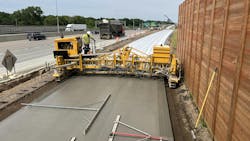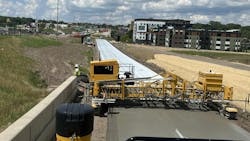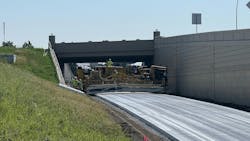How Concrete is Shaping Rapid Transit Systems
By Kristin Dispenza, Contributing Author
It has been nearly 50 years since investments from the Urban Mass Transportation Administration—predecessor to today’s Federal Transit Administration (FTA)—gave rise to the United States’ first dedicated bus lane, located in Pittsburgh.
By the early 2000s, several major cities had launched full-service Bus Rapid Transit (BRT) systems. Despite these achievements, there were lessons to be learned as bus-based transit grew into a sophisticated, modern system.
Over the years, many opportunities for improvement were identified to achieve faster and more efficient mobility for the public. In addition to creating dedicated bus lanes and busways, reconfigurations of surrounding infrastructure were constructed, such as the addition of pedestrian bridges and elevated platforms for level loading. Stations were enhanced and transit signal priorities were implemented to move buses through traffic faster.
Early discussions about pavement material often focused on the need for easy visual identification of the bus lanes, with asphalt and concrete being used side by side to differentiate between the lanes’ uses. It took time and experience for pavement material to begin to be selected based upon structural needs.
As bus lane implementation grew, asphalt pavements proved to be susceptible to rutting and shoving, creating “hills” for busses to climb their way out of, which risked increasing fuel expenses and compromising rider comfort. It also could damage a bus, resulting in higher maintenance costs.
Bus pads were some of the first BRT pavements to be constructed of concrete.
Dedicated bus lanes are particularly damaging to asphalt pavements because of buses’ weight and axle configuration. Buses also are slow moving and make a lot of stops and starts, increasing load time and therefore increasing the deflection of asphalt pavement.
Furthermore, the forces generated by braking and or the heat from idling buses can distort bituminous materials.
A standard developed by the American Public Transportation Association (APTA), “Designing Bus Rapid Transit Running Ways,” recommends busway pavement be designed according to traffic volume, where volume is represented by the number of equivalent standard axles.
The design life for flexible pavements is 20 years (which includes an overlay of 2 inches at approximately the 12- to 15-year point), whereas concrete pavements can be expected to have a 40-year design life. The standard states, “a whole-life analysis of the alternatives is required to produce an equitable comparison.”
Smoothness is another benefit offered by concrete pavements. Smoother driving surfaces last longer, and smoothness is considered important for bus safety, rider comfort and fuel efficiency. The use of concrete also helps maintain more accessible surfaces where bus zones connect with crosswalks and bicycle lanes.
Minnesota’s Metro Gold Line
The Twin Cities area of Minnesota has one of the most developed BRT systems to date, with Minnesota State Rep. Frank Hornstein stating at a 2022 Metro Transit ribbon cutting ceremony, “We are well on our way to making this the bus rapid transit capital of North America.”
The Metro Gold Line, a BRT line connecting St. Paul to Woodbury, opened in March. It is the region’s sixth BRT and one of three Metro BRT lines scheduled to open this year. It also is Minnesota's first BRT that operates primarily within bus-only lanes. These lanes are dedicated to transit buses and lie generally north of and near Interstate-94.
“Bus pads have been used for many years in the Twin Cities area, achieving long service lives while requiring minimal maintenance. Therefore, concrete was recognized as the right pavement choice to meet the demands of the Gold Line’s dedicated bus lanes,” said Dan Labo, executive director, Concrete Paving Association of Minnesota (CPAM).
For the 10-mile Gold Line project, 6.4 miles were paved in concrete.
“Dedicated, bus-only lanes were paved with concrete,” said Chad Lind, project manager and estimator, Doyle Conner Co. “Lanes that are shared by both buses and cars remained asphalt.”
Standard MnDOT highway construction specifications were also used, so load transfer was accomplished using 1.25-inch diameter epoxy coated dowel bars, 15 inches in length and spaced 12 inches on center, for all transverse joints.
Number four (1/2-inch diameter) tie bars were installed at longitudinal joints, spaced 36 inches on center. The pavements are 8 inches thick.
Pavement smoothness and a high standard of ride quality were major considerations for the project. For surface texturing, Doyle Conner Co. used a longitudinal broomed texture and some diamond grinding.
Since Gold Line dedicated bus lanes occupy mainly two-lane frontage roads, including roads along the I-94 corridor and the I-94/Interstate-694 interchange, the site was narrow and construction access was limited by the presence of highway ramps, retaining walls and homes and businesses.
This made end-to-end paving operations impossible; the slipform paving and subsequent surface texturing operations required many stops and starts and project phasing. Despite this challenge, the contractors met Metro Transit’s stringent smoothness requirements. International roughness index (IRI) measurements averaged approximately 70.
In all, 82,000 square yards of concrete pavement were installed and 19,400 dowel bars were used, along with 79,000 pounds of tie bar steel and supplemental reinforcing steel. Reinforcing steel was used to protect selected panels that were positioned over storm pipes and shallow utilities.
A Transit Solution
According to the FTA, BRT is one of the fastest growing transit modes in the nation. Many cities find it more economical than rail lines. And as noted in the report, “Bus Rapid Transit (BRT): An Efficient and Competitive Mode of Public Transport” from the Berkeley Institute of Urban and Regional Development, “high-quality bus-based systems…better serve the low-density settlement patterns of many suburban markets and small-to-medium size cities due to the inherent flexibility advantages of rubber-tire systems.”
Therefore, BRT is an excellent transportation solution for many municipalities within the United States, and it can be expected that the growth and development of BRT systems will continue. Concrete pavement will play a vital role as these systems advance. RB
Kristin Dispenza is a senior account manager at Advancing Organizational Excellence.


